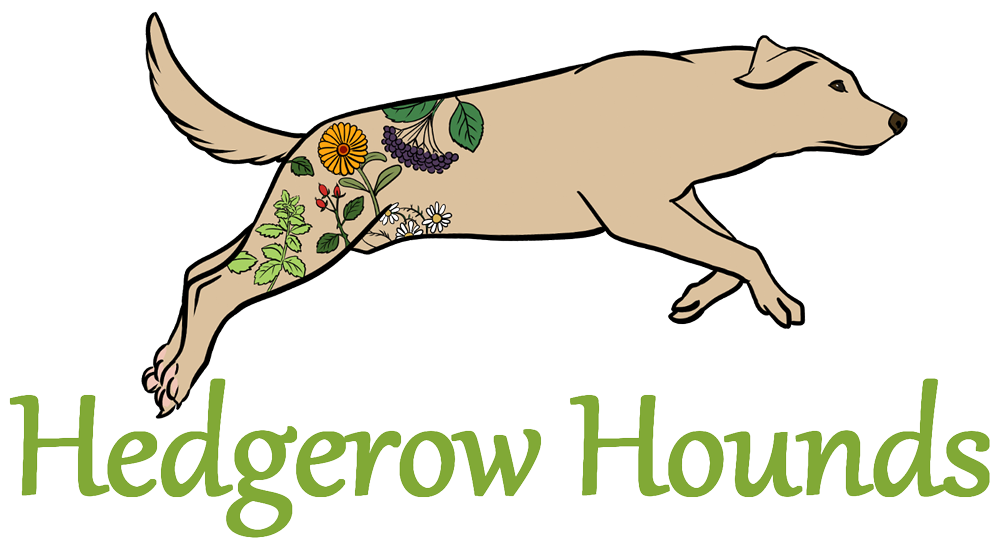For centuries animals have relied upon the medicinal powers of plants to assist in the healing of many aliments. They were instinctively drawn to herbs, grasses, seeds and roots in woodland and open ground to help everything from parasite control to intestinal discomfort.
Adding fresh, homegrown herbs to your dog’s meals can provide many benefits. They offer a gentle, cleansing and balancing effect to the body, provide phytonutrients and fibre, which in turn benefit the gut bacteria and add moisture to the diet of dogs that are fed dried food.
If you can pick a few herbs then immediately prepare and add them to your dog’s food, the nutritional benefits will be at their peak. Fed like this even a little goes a long way.
The herbs and wild ingredients mentioned below can be brought as young plants, sown as seeds, or foraged for.
Even a sunny windowsill or balcony can be used to grow a few herbs. They just need a little well drained soil, water, some sun and a bit of care to give you a huge amount back.
Here are some of my favourites, which you can enjoy yourself and share with your dog.
Parsley
If you only have room for one herb, then parsley would be the one.
The most common varieties are curly and flat leaf, and the leaf, stem and root can be used. The flat leaf parsley is more closely related to the wild species.
It is traditionally used to support digestive and urinary tract issues and as a breath freshener. It is high in antioxidants such as beta-carotene and lycopene which help fight inflammation and used to support arthritic conditions.
Parsley is rich in vitamin A, C, B1, B2, K, calcium, riboflavin, potassium, iron, magnesium, manganese, niacin, phosphorous, fibre and chlorophyll.
Very finely chop the leaves and stalks or add into a blender with your dog’s normal vegetables. As a rough guide my Labradors would have a heaped tablespoon each, added in with their vegetables most days over the Summer.
Thyme
Thyme has antimicrobial, expectorant and astringent qualities and can help soothe a cough or cold by loosening mucus.
Thyme has quite a strong flavour and aroma compared with the other herbs listed, so would be used a little more sparingly. This is one to introduce initially in tiny amounts to see if your dog likes the taste. They may however just enjoy the scent if you crush a few leaves and then offer your hand to sniff if they wish. The stems are generally too woody to use so just pick off a few of the tiny leaves instead.
Dandelion
The humble dandelion is not only a friend to pollinators it is also a very good addition to our own and our dog’s diet.
The leaf has affinities with the liver, gall bladder and kidneys and act as a gentle blood cleanser, laxative and bitter tonic. Bitter tasting ingredients promote salivation which in turn improves digestion. Traditionally dandelion would be used alongside burdock root for a powerful combination.
The leaves are a rich source of vitamin A, D, K, B complex, Iron, Manganese, Phosphorous, Potassium and the flowers are a good source of Lecithin.
We can add the leaves and petals to salads or use in the same way as spinach. In spring and early summer, I pick and wash dandelion leaves and add to the dog’s vegetable blend, along with parsley, courgette, chard and a few lettuce leaves. This is all put in the blender with a tiny splash of water and whizzed to a thick smoothie consistency and makes up to 15% of the meal.
Nettle
The nettle is seen as “the enemy” to many gardeners, yet it not only provides a haven for wildlife it is also packed with nutrition and makes fantastic teas, soups, and pesto.
Rich in Iron, vitamin A, C, D and B complex, Silica, Calcium, Phosphorous, Magnesium, Beta-carotene and Potassium.
Only the tops of the nettles should be picked and used from early spring to around the end of May. As the plant matures it develops tiny crystalline particles which irritate the urinary tract and kidneys.
Nettles have natural antihistamine properties and can also be used as a coat rinse.
The process of drying or cooking the nettles neutralises their sting, although you will need gloves in order to pick them or they will definitely fight back!
Picked nettles can be dried for a couple of days on paper in the sun or if the whole stem is cut, hang upside down to dry in small bundles and just use the leaves from the tips. Once dried you can crumble them easily with your fingers.
Fennel
Fennel is similar to dill in its appearance but has a strong aniseed scent and grows large fennel bulbs. The delicate, feathery leaves, seeds and root can be used and primarily taken to improve digestion, ease bloating, reflux, mild tummy ache and increase milk flow in nursing mothers. It is rich in vitamin C, A, calcium, iron and potassium.
Safety:
When harvesting any herb or wild ingredient there are a few things to consider so you can safely use them.
Firstly, it is essential to be able to accurately identify what you are picking. This can take a little time and the use of a good identification book is extremely helpful.
Always forage away from roadsides and arable crops, which will no doubt have been sprayed with chemicals or exposed to pollutants.
Caroline Hearn MICHT. Dip ICAT. MIAAT
Canine & Equine Sports & Remedial Massage and Holistic Therapist

